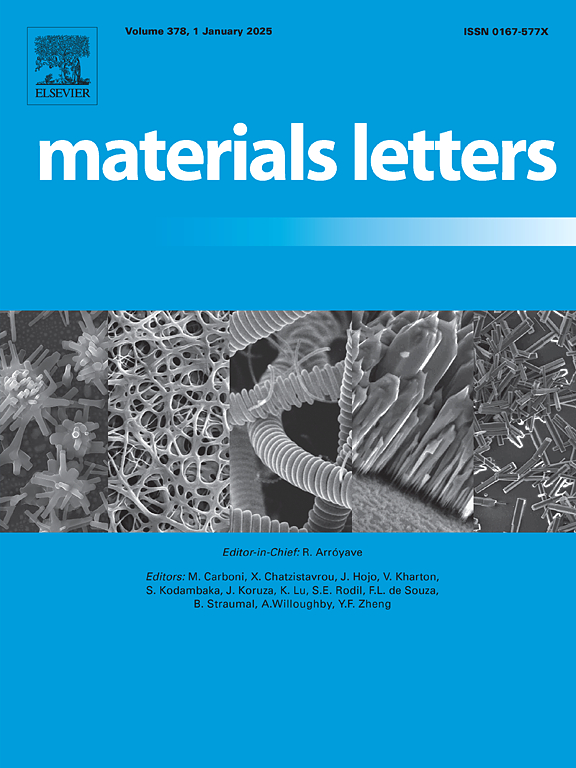Porous 3D boron nitride meteorite as an efficient and reusable adsorbent for antibiotic removal
IF 2.7
4区 材料科学
Q3 MATERIALS SCIENCE, MULTIDISCIPLINARY
引用次数: 0
Abstract
To address environmental pollution induced by coexisting antibiotics, a three-dimensional porous boron nitride meteorite adsorbent (P-BNM) with hierarchical architecture was fabricated via a MgO template-assisted approach. The adsorption performance was systematically investigated for three representative antibiotics: tetracycline (TC), oxytetracycline hydrochloride (OTC), and ciprofloxacin (CIP). The optimized porous structure with enhanced surface area enabled removal efficiencies of 84.9 %, 84.2 %, and 93.7 % for TC, OTC, and CIP, respectively. Effective regeneration of spent P-BNM was demonstrated through thermal treatment at 500 °C for 2 h, retaining removal efficiencies above 88 %, 90 %, and 92 % for TC, OTC, and CIP over five consecutive cycles. This study elucidates that constructing hierarchical BN architectures via MgO-assisted templating enables superior adsorption capacity and size-selective antibiotic removal through precisely tailored pore structures. The developed adsorbent shows promising potential for implementation in advanced water treatment systems.
多孔三维氮化硼陨石作为一种高效、可重复使用的抗生素去除吸附剂
为了解决共存抗生素对环境的污染问题,采用MgO模板辅助法制备了具有分层结构的三维多孔氮化硼陨石吸附剂(P-BNM)。系统考察了三种代表性抗生素:四环素(TC)、盐酸土霉素(OTC)和环丙沙星(CIP)的吸附性能。优化后的多孔结构具有更大的表面积,对TC、OTC和CIP的去除效率分别为84.9%、84.2%和93.7%。通过在500°C下热处理2小时,证明了废P-BNM的有效再生,在连续5个循环中,TC、OTC和CIP的去除率分别保持在88%、90%和92%以上。该研究表明,通过mgo辅助模板构建分层BN结构可以通过精确定制的孔结构实现优越的吸附能力和大小选择性抗生素去除。所开发的吸附剂在高级水处理系统中具有良好的应用前景。
本文章由计算机程序翻译,如有差异,请以英文原文为准。
求助全文
约1分钟内获得全文
求助全文
来源期刊

Materials Letters
工程技术-材料科学:综合
CiteScore
5.60
自引率
3.30%
发文量
1948
审稿时长
50 days
期刊介绍:
Materials Letters has an open access mirror journal Materials Letters: X, sharing the same aims and scope, editorial team, submission system and rigorous peer review.
Materials Letters is dedicated to publishing novel, cutting edge reports of broad interest to the materials community. The journal provides a forum for materials scientists and engineers, physicists, and chemists to rapidly communicate on the most important topics in the field of materials.
Contributions include, but are not limited to, a variety of topics such as:
• Materials - Metals and alloys, amorphous solids, ceramics, composites, polymers, semiconductors
• Applications - Structural, opto-electronic, magnetic, medical, MEMS, sensors, smart
• Characterization - Analytical, microscopy, scanning probes, nanoscopic, optical, electrical, magnetic, acoustic, spectroscopic, diffraction
• Novel Materials - Micro and nanostructures (nanowires, nanotubes, nanoparticles), nanocomposites, thin films, superlattices, quantum dots.
• Processing - Crystal growth, thin film processing, sol-gel processing, mechanical processing, assembly, nanocrystalline processing.
• Properties - Mechanical, magnetic, optical, electrical, ferroelectric, thermal, interfacial, transport, thermodynamic
• Synthesis - Quenching, solid state, solidification, solution synthesis, vapor deposition, high pressure, explosive
 求助内容:
求助内容: 应助结果提醒方式:
应助结果提醒方式:


